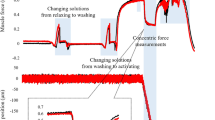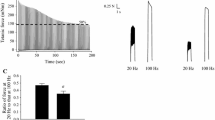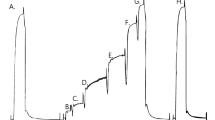Abstract
This study investigated the effects of fibre swelling on force production in rat and human skinned muscle fibres, using osmotic compression to reverse the fibre swelling. In mechanically-skinned fibres, the sarcolemma is removed but normal excitation–contraction coupling remains functional. Force responses in mechanically-skinned fibres were examined with and without osmotic compression by polyvinylpyrrolidone 40 kDa (PVP-40) or Dextran 500 kDa (dextran). Fibre diameter increased to 116 ± 2% (mean ± SEM) when rat skinned type II fibres were immersed in the standard intracellular solution, but remained close to the in situ size when 3% (mass/volume) PVP-40 or 4% Dextran were present. Myofibrillar Ca2+ sensitivity, as indicated by pCa50 (− log10[Ca2+] at half-maximal force), was increased in 4% Dextran (0.072 ± 0.007 pCa50 shift), but was not significantly changed in 3% PVP-40. Maximum Ca2+-activated force increased slightly to 103 ± 1% and 104 ± 1% in PVP-40 and Dextran, respectively. Both tetanic and depolarization-induced force responses in rat skinned type II fibres, elicited by electrical stimulation and ion substitution respectively, were increased by ~ 10 to 15% when the fibres were returned to their normal in situ diameter by addition of PVP-40 or Dextran. Interestingly, the potentiation of these force responses in PVP-40 was appreciably greater than could be explained by potentiation of myofibrillar function alone. These results indicate that muscle fibre swelling, as can occur with intense exercise, decreases evoked force responses by reducing both the Ca2+-sensitivity of the contractile apparatus properties and Ca2+ release from the sarcoplasmic reticulum.





Similar content being viewed by others
References
Allen DG, Lamb GD, Westerblad H (2008) Skeletal muscle fatigue: cellular mechanisms. Physiol Rev 88:287–332
Cheng AJ, Place N, Westerblad H (2018) Molecular basis for exercise-induced fatigue: the importance of strictly controlled cellular Ca2+ handling. Cold Spring Harb Perspect Med 8:a029710
Coonan JR, Lamb GD (1998) Effect of transverse-tubular chloride conductance on excitability in skinned skeletal muscle fibres of rat and toad. J Physiol 509:551–564
Debold EP, Fitts RH, Sundberg CW, Nosek TM (2016) Muscle fatigue from the perspective of a single crossbridge. Med Sci Sports Exerc 48:2270–2280
Dutka TL, Lamb GD (2007) Na+-K+ pumps in the transverse tubular system of skeletal muscle fibers preferentially use ATP from glycolysis. Am J Physiol-Cell Physiol 293:C967–C977
Dutka TL, Murphy RM, Stephenson DG, Lamb GD (2008) Chloride conductance in the transverse tubular system of rat skeletal muscle fibres: importance in excitation-contraction coupling and fatigue. J Physiol 586:875–887
Farman GP, Walker JS, de Tombe PP, Irving TC (2006) Impact of osmotic compression on sarcomere structure and myofilament calcium sensitivity of isolated rat myocardium. Am J Physiol-Heart Circ Physiol 291:H1847–H1855
Fenwick AJ, Leighton SR, Tanner BC (2016) Myosin MgADP release rate decreases as sarcomere length increases in skinned rat soleus muscle fibers. Biophys J 111:2011–2023
Fitts RH (2008) The cross-bridge cycle and skeletal muscle fatigue. J Appl Physiol 104:551–558
Godt RE, Maughan DW (1981) Influence of osmotic compression on calcium activation and tension in skinned muscle fibers of the rabbit. Pflugers Arch 391:334–337
Haaf F, Sanner A, Straub F (1985) Polymers of N-vinylpyrrolidone: synthesis, characterization and uses. Polym J 17:143–152
Karatzaferi C, de Haan A, Ferguson RA, van Mechelen W, Sargeant AJ (2001) Phosphocreatine and ATP content in human single muscle fibres before and after maximum dynamic exercise. Pflugers Arch 442:467–474
Lamb GD (2000) Excitation-contraction coupling in skeletal muscle: comparisons with cardiac muscle. Clin Exp Pharmacol Physiol 27:216–224
Lamb GD, Stephenson DG (2018) Measurement of force and calcium release using mechanically skinned fibers from mammalian skeletal muscle. J Appl Physiol 125:1105–1127
Lamb GD, Stephenson DG, Stienen GJ (1993) Effects of osmolality and ionic strength on the mechanism of Ca2+ release in skinned skeletal muscle fibres of the toad. J Physiol 464:629–648
Lamb GD, Junankar PR, Stephenson DG (1995) Raised intracellular [Ca2+] abolishes excitation-contraction coupling in skeletal muscle fibres of rat and toad. J Physiol 489:349–362
Lamb GD, Cellini MA, Stephenson DG (2001) Different Ca2+ releasing action of caffeine and depolarisation in skeletal muscle fibres of the rat. J Physiol 531:715–728
Lamboley CR, Wyckelsma VL, Dutka TL, McKenna MJ, Murphy RM, Lamb GD (2015) Contractile properties and sarcoplasmic reticulum calcium content in type I and type II skeletal muscle fibres in active aged humans. J Physiol 593:2499–2514
Lannergren J (1990) Volume changes of isolated Xenopus muscle fibres associated with repeated tetanic contractions. J Physiol 420:116P
Lindinger MI, Heigenhauser GJ, Spriet LL (1987) Effects of intense swimming and tetanic electrical stimulation on skeletal muscle ions and metabolites. J Appl Physiol 63:2331–2339
O’Connell B, Stephenson DG, Blazev R, Stephenson GM (2004) Troponin C isoform composition determines differences in Sr2+-activation characteristics between rat diaphragm fibers. Am J Physiol Cell Physiol 287:C79–C87
Posterino GS, Lamb GD, Stephenson DG (2000) Twitch and tetanic force responses and longitudinal propagation of action potentials in skinned skeletal muscle fibres of the rat. J Physiol 527:131–137
Roos KP, Brady AJ (1990) Osmotic compression and stiffness changes in relaxed skinned cardiac myocytes in PVP-40 and dextran T-500. Biophys J 58:1273–1283
Sahlin K, Alvestrand A, Brandt R, Hultman E (1978) Intracellular pH and bicarbonate concentration in human muscle during recovery from exercise. J Appl Physiol Respir Environ Exerc Physiol 45:474–480
Sjogaard G, Adams RP, Saltin B (1985) Water and ion shifts in skeletal muscle of humans with intense dynamic knee extension. Am J Physiol-Regul Integr Comp Physiol 248:R190–R196
Tsuchiya T (1988) Passive interaction between sliding filaments in the osmotically compressed skinned muscle fibers of the frog. Biophys J 53:415–423
Wang YP, Fuchs F (1995) Osmotic compression of skinned cardiac and skeletal muscle bundles: effects on force generation, Ca2+ sensitivity and Ca2+ binding. J Mol Cell Cardiol 27:1235–1244
Acknowledgements
We thank Ms Maria Cellini for her technical assistance and the National Health and Medical Research Council of Australia (to G. D. Lamb, Grant No. 1085331) and Japan Society for the Promotion of Science (to D. Watanabe, Grant No. 16J01194) for financial support.
Author information
Authors and Affiliations
Corresponding author
Additional information
Publisher's Note
Springer Nature remains neutral with regard to jurisdictional claims in published maps and institutional affiliations.
Rights and permissions
About this article
Cite this article
Watanabe, D., Dutka, T.L., Lamboley, C.R. et al. Skeletal muscle fibre swelling contributes to force depression in rats and humans: a mechanically-skinned fibre study. J Muscle Res Cell Motil 40, 343–351 (2019). https://doi.org/10.1007/s10974-019-09521-1
Received:
Accepted:
Published:
Issue Date:
DOI: https://doi.org/10.1007/s10974-019-09521-1




